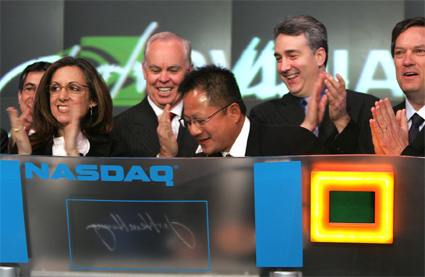Analysis: Nvidia's Ageia Purchase - A Brilliant Move?
Nvidia inside
At the end of the day, the Ageia acquisition could be another lucrative acquisition for Nvidia that can be traced down to Jen-Hsun Huang, known to industry insiders as an extremely dedicated individual who is lucky enough to have the whole company behind him.
The reason for this almost fanatical fellowship at Nvidia lies within some publicized events in Nvidia's past. For instance, when Nvidia has hit with the trouble surrounding the GeForce FX, Jen-Hsun Huang and the executive decided not to fire anyone. Cost-cutting was mainly done on the executive level, but unlike Apple's $1 salary, this move was not advertised at all. All of the executives did not took any bonuses and invested heavily in the company, also reducing their salary to the legal minimum (read: Steve Jobs salary minus the stock options), just to get through rough weather. The storm did not last for long, but the executive team got a massive payoff: The whole company is now said to stands by its leadership and the constant expansion only speaks of the power the company now has.
When AMD acquired ATI, several industry insiders and analysts were quick to say that Nvidia's days are over. With Intel Larrabee on one side and AMD Fusion on another, wiping out Nvidia was expected to be a walk in the park. However, today Nvidia is a billion dollar per quarter company. We have often said that we expect GPGPUs the next big thing and Nvidia's CUDA is in place to take advantage of this trend. Nvidia's current market cap is $14.46 billion, while AMD is at $4.59 billion.
Sadly for Jen-Hsun Huang, Nvidia could not took over AMD, since he reportedly was unable to generate support for the move - despite he publicly always said that he isn't interested in CPUs, but wanted to focus on graphics instead. We heard that the debt-to-equity ratio was too big for the current size of the company. It will be interesting to see what will happen when Fusion and Nehalem arrive on desktop and mobile platforms. There have been talks that AMD could become an interesting acquisition target once cost is under control and there is more visibility how effective its roadmap will be. There may be another chance for Huang.
With integration of PhysX into its products, Nvidia is providing a clear signal that the nForce chipset is not going anywhere and that the company will continue to squeeze the CPU to the point where the CPU is just another component of a computer, regardless of Intel's plans to integrate everything into Nehalem/QuickPath interface (formerly known as CSI: Santa Clara or Nehalem's direct interconnect like Hypertransport). The only thing that Nvidia will have to be careful about are FSB licenses. If that is the case, the company will continue to be a formidable rival.
Current page: Nvidia inside
Prev Page Why Ageia matters Next Page Conclusion: Nvidia claims a key spot in next-generation console and PCsGet Tom's Hardware's best news and in-depth reviews, straight to your inbox.
